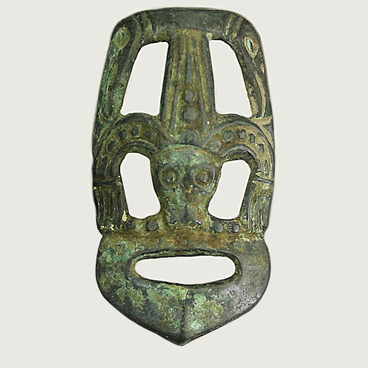Archaeologists often find jewelry of Bulgarian craftsmen on the territory of Western Siberia. The Volga Bulgars were famous for their jewelry made of metals and semi-precious stones: lapis lazuli, rock crystal, carnelian. Their items were exchanged for furs thousands of kilometers away from the workshops. According to researchers, the branch of Bulgarian silver making, which focused on the Ob region customers, dilapidated only in the 16th century, after the annexation of the Khanate of Kazan to the Moscow state.
Crescent-shaped pendants are one of the most common Bulgarian items found on the territory of Western Siberia. Researchers believe that “lunulas” were popular items in Bulgaria. In the culture of many peoples, a lunula is an exclusively female sign, it symbolizes motherhood, abundance, and fertility.
From the Bronze Age, this type of pendants was common in Byzantium, the Roman Empire, Moravia, and Ireland. On the territory of modern Russia, in addition to Volga Bulgaria, similar jewelry was made in the Permian Urals, the Southern Urals, and the Trans-Urals. Not only pendants were made in the form of a crescent, but also earrings, details of a headdress. The image of the lunula was also embroidered on clothes.
The item was worn not only as a decoration, but also as an amulet. For example, pregnant women tied the lunula on the belt. It was believed that such a pendant protects both a mother and a child.
The Bulgarian crescent-shaped pendant is housed in the exhibition “Ugra Heritage”. It is about 1,000 years old. The decoration is made of a gilded shield, in the center of which is a rough frame with an insert of carnelian beads. A thin plate of silver foil is soldered on the back side. Lunulas are decorated in the ancient techniques of “filigree” and “granulating”. Filigree was a technique in which a pattern was soldered with a very thin twisted metal cord, and granulating was ornamentation with small metal balls.
The pendant was found by employees of the Laboratory of Archaeographic Research of the Ural Federal University during excavations near the lake Syrkovy Sor in the Nefteyugansk District. The exhibit entered the museum in 1997.
Crescent-shaped pendants are one of the most common Bulgarian items found on the territory of Western Siberia. Researchers believe that “lunulas” were popular items in Bulgaria. In the culture of many peoples, a lunula is an exclusively female sign, it symbolizes motherhood, abundance, and fertility.
From the Bronze Age, this type of pendants was common in Byzantium, the Roman Empire, Moravia, and Ireland. On the territory of modern Russia, in addition to Volga Bulgaria, similar jewelry was made in the Permian Urals, the Southern Urals, and the Trans-Urals. Not only pendants were made in the form of a crescent, but also earrings, details of a headdress. The image of the lunula was also embroidered on clothes.
The item was worn not only as a decoration, but also as an amulet. For example, pregnant women tied the lunula on the belt. It was believed that such a pendant protects both a mother and a child.
The Bulgarian crescent-shaped pendant is housed in the exhibition “Ugra Heritage”. It is about 1,000 years old. The decoration is made of a gilded shield, in the center of which is a rough frame with an insert of carnelian beads. A thin plate of silver foil is soldered on the back side. Lunulas are decorated in the ancient techniques of “filigree” and “granulating”. Filigree was a technique in which a pattern was soldered with a very thin twisted metal cord, and granulating was ornamentation with small metal balls.
The pendant was found by employees of the Laboratory of Archaeographic Research of the Ural Federal University during excavations near the lake Syrkovy Sor in the Nefteyugansk District. The exhibit entered the museum in 1997.



